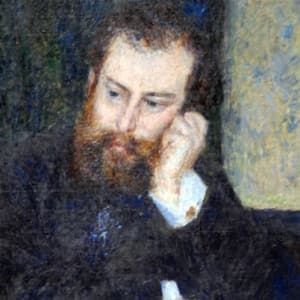
Alfred Sisley was born on October 30, 1839, in Paris, France. The Franco-German War financially ruined the Sisley family, but Sisely still decided to make painting his full-time career and stuggled with poverty for the rest of his life. He was an associate of Claude Monet and Pierre-Auguste Renoir. Sisley died in Moret-sur-Loing, France, in 1899.
The consummate landscape painter, Alfred Sisley was born to English parents on October 30, 1839, in Paris, France. In 1857, he made his first trip to London, England, where he was inspired by the work of such English landscape painters as J.M.W. Turner, John Constable and Richard Parkes Bonington. Sisley joined other Impressionist artists such as Claude Monet, Camille Pissarro and Pierre-Auguste Renoir in flouting the strict methods of the École des Beaux-Arts (formerly the Académie des Beaux-Arts, Paris) in favor of a more naturalistic and realistic portrayal of his subjects.
In 1868, Alfred Sisley's landscape "Avenue of Chestnut Trees near La Celle Saint-Cloud (Southampton)" was shown at the prestigious Salon art exhibition. The painting drew upon the soft tonality of Camille Corot and the dramatic massing of Gustave Courbet, both of whom were a strong influence on the artist. Sisley displayed six landscapes at the first Impressionist exhibition, and all were largely criticized. Like many of his contemporaries, he was condemned for his loose and apparently unfinished execution in such works as "Autumn: Banks of the Seine near Bougival" (1873; Montreal).
Of all of the Impressionist artists of the period, Alfred Sisley was the purest landscape painter. He painted nearly 900 oil paintings, less than a dozen of which were still lifes and only one or two of which were genre scenes. The remainder were landscapes spanning from the forests of Fontainebleau and Louveciennes, London, to Wales and Moret-sur-Loing. He eschewed cityscapes, industrialization and human figures for the serenity of a pastoral setting.
Under the patronage of the French baritone Jean-Baptiste Faure, Alfred Sisley was able to return to England in 1874. While there, he painted a series of canvases at Hampton Court, including "Molesey Weir, Hampton Court" (1874; Edinburgh), which has been deemed remarkably fresh and spontaneous. "Molesey Weir" appears relaxed and informal, with its portrayal of naked bathers having been executed with great economy of means.
Sisley exhibited at the second and third Impressionist exhibitions, but it wasn't until he received a mention in Georges Rivière's L'Impressioniste that the painter received any critical acclaim. Rivière wrote of Sisley's charming talent, taste, subtlety and tranquility.
Alfred Sisley portrayed a timeless view of nature in which man, although present, is never the controlling force. He died of throat cancer on January 29, 1899, in Moret-sur-Loing, France.